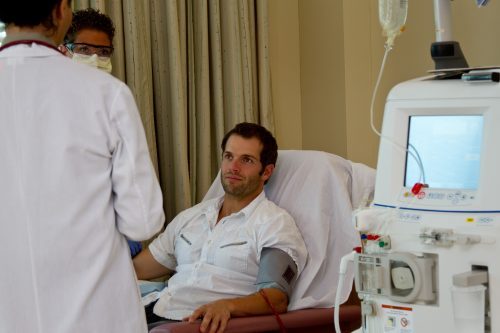
Black Americans have a greater incidence of chronic kidney disease (CKD) than White individuals. This difference is likely due, in part, to variants in the apolipoprotein L1 (APOL1) gene. Approximately 12% to 15% of Black Americans carry two APOL1 risk variants; they are virtually absent in people of European ancestry.
Previous research has determined that patients with CKD who have two APOL1 kidney risk variants (high-risk genotype) experience a more rapid decline in kidney function compared with those who have one or zero variants (low-risk genotype). Thus, physicians may test Black patients with CKD and proteinuria for APOL1 kidney risk variants. APOL1 genetic testing is also used to evaluate Black living kidney donor (LKD) candidates to help determine their level of risk for future kidney disease. However, most patients carrying the high-risk APOL1 genotype will not develop kidney disease; a second hit is required. It is unclear from current research whether kidney donation is the instigating event for some LKDs carrying the high-risk APOL1 genotype to progress to CKD or end-stage renal disease (ESRD).
There is a gap in knowledge regarding the baseline risk of kidney disease in healthy patients with two APOL1 variants. This information could help clinicians better understand the effect of the high-risk APOL1 genotype on postdonation outcomes and guide unaffected family members of patients with APOL1-mediated kidney disease. Thus, a team of researchers led by Mona D. Doshi, MBBS, used data from the Atherosclerosis Risk in Communities (ARIC) study to evaluate the effect of self-reported race and APOL1 genotype on long-term kidney function in a cohort of healthy patients aged 45-64 years. The researchers hypothesized that having the APOL1 high-risk genotype does not adversely affect the long-term kidney function of those who survive to middle-age with good health and normal kidney function. Their results were published in Kidney Medicine.
ARIC launched in 1987 and enrolled 15,792 participants aged 45-64 years, of whom 15,026 (95%) consented to public use of their data. The researchers used ARIC to identify healthy middle-aged individuals who met criteria for LKD selection (blood pressure <140/90 mm Hg, fasting blood sugars <126 mg/dL, nonuse of antihypertensive and diabetic medications, estimated glomerular filtration rate [eGFR] ≥80 mL/min/1.73 m2, and body mass index <35 kg/m2). A total of 5886 (39%) participants met the eligibility criteria at the time of enrollment.
Race was self-reported; participants who reported Black race were genotyped for APOL1 kidney risk variants. Selected participants were divided into three groups: 5075 White participants (86%), 54% of whom were women; 110 Black participants with the APOL1 high-risk genotype (2%), 60% women; and 70 Black participants with the APOL1 low-risk genotype (12%), 58% women. Individuals with race other than Black or White were excluded. The mean age at baseline was 53 ± 6 years.
The primary outcome was eGFR at 10 and 25 years, percentage of patients with CKD stage 3a or higher (creatinine- and cystatin C-based eGFR [eGFRcr-cys] ≤60 mL/min/1.73 m2), and microalbuminuria (urinary albumin-creatinine ratio [UACR] >30 mg/g) in each group. The secondary outcome was the percentage of patients among healthy participants from the main ARIC cohort, including those who declined public use of their data (n=6980) to reach ESRD, death, or both.
At 10 years, White subjects had lower eGFRcr-cys than the low-risk and high-risk Black groups (89 ± 16 vs 91 ± 16 and 92 ± 15 mL/min/1.73 m2, respectively; P<.001). White participants again had lower eGFRcr-cys than the low-risk Black group at 25 years (70 ± 18 vs 72 ± 19 mL/min/1.73 m2; P<.001). However, this was not true in comparison with the high-risk Black group (67 ± 23 mL/min/1.73 m2). There was no difference in UACR among the groups at 10 years (P=.87) or 25 years (P=.91).
At 10 years, the percentage of participants with CKD stage 3a or higher was highest in the White and low-risk Black groups versus the high-risk Black group (3.4% and 3.9% vs 1.4%, respectively; P=.02). At 25 years, the three groups were comparable (30% in White, 25% in low-risk Black, and 33% in high-risk Black participants, respectively; P=.22). The chances of developing CKD stage 3a or worse did not differ in White participants or the low-risk participants versus the high-risk participants in either the unadjusted or adjusted model (P=.61 and P=.91, respectively).
Regarding the secondary outcome, ESRD rates and death rates were the same among all three groups. At 30 years, <5% of the full cohort had ESRD; the composite ESRD and death rate for the full cohort was 45%.
The authors acknowledged a few major limitations of the study. These include large and variable intervals between study visits, resulting in greater loss to follow-up, and a lack of information on family history of ESRD in first-degree relatives, which is a significant risk factor for advanced kidney disease.
“In conclusion,” the authors wrote, “we report a lack of association of the APOL1 genotype with long-term kidney function among middle-aged Black individuals screened for good health and absence of kidney disease at baseline.” They determined that, “[g]iven the data we have to date, despite the study limitations, we recommend that Black middle-aged and older individuals considering kidney donation or unaffected family members of patients with CKD attributed to APOL1 should be educated about APOL1 kidney risk variants and the availability of APOL1 testing. In addition, these individuals should be counseled that APOL1 kidney risk variants are not major drivers of their future risk of kidney disease.”
Source: Kidney Medicine







 © 2025 Mashup Media, LLC, a Formedics Property. All Rights Reserved.
© 2025 Mashup Media, LLC, a Formedics Property. All Rights Reserved.